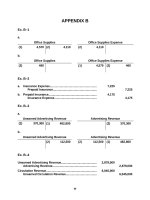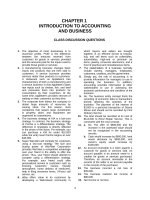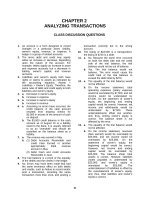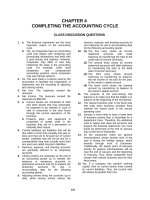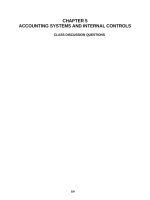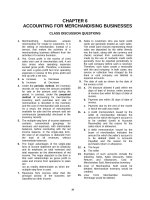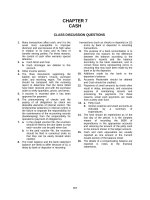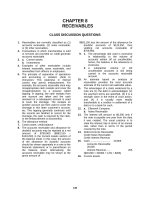Solution manual investments 10th by jones ch11
Bạn đang xem bản rút gọn của tài liệu. Xem và tải ngay bản đầy đủ của tài liệu tại đây (50.15 KB, 10 trang )
Chapter 11:
Common Stocks: Analysis And Strategy
CHAPTER OVERVIEW
Chapter 11 completes a two-chapter sequence on the analysis,
valuation, and management of common stocks--the same sequence
used earlier for bonds. This chapter concentrates on issues
important to the analysis and management of common stocks, given
that the valuation of stocks was discussed in Chapter 10. Market
efficiency is covered in Chapter 12.
This arrangement allows us to efficiently cover common
stocks by discussing valuation in Chapter 10, analysis and
management in Chapter 11, and market efficiency in Chapter 12.
This provides an in-depth discussion of common stocks that in
many cases will suffice for an introductory course; that is,
instructors may choose to forego Part V on security analysis, or
cover it in less detail. Students will be exposed to the basic
terminology, ideas, and concepts involving common stocks by
covering these three chapters.
Chapter 11 begins by analyzing common stocks in terms of the
impact of the market on common stocks (obviously a major
consideration) and in terms of the required rate of return for
common stocks (a very important concept covered briefly in
earlier chapters). Now that we are analyzing stocks in detail, a
full discussion of these two key topics is extremely valuable.
Earlier chapters defined and briefly discussed systematic
risk and beta, and we can now emphasize that all investors who
plan to analyze and manage a portfolio of stocks must be keenly
aware of market risk, both domestic and foreign. In a similar
manner, in Chapter 10, in order to concentrate on the techniques
of valuation, we assumed that we knew the discount rate or
required rate of return. Here we consider it in detail because
of its importance to any successful understanding of stocks.
Chapter 11 relates to themes developed in Chapter 19, where
it is noted that investors often consider the investment decision
as consisting of two steps, asset allocation and security
selection. We are assuming here that the asset allocation
decision has been made.
159
Following the comparable chapter in the bond sequence
(Chapter 9), the discussion of how investors should approach the
analysis and management of stocks is divided into the two major
alternatives, passive strategies and active strategies. This
division is an effective and realistic way to organize this
discussion, and once again allows the instructor flexibility in
bringing up such topics as Efficient Markets.
The passive strategy discussion covers the buy-and-hold
strategy and index funds. The active strategy discussion covers
the major alternatives investors have when pursuing an active
approach--security selection, sector rotation, and market timing.
This discussion is followed by a consideration of how Efficient
Markets concepts affect active strategies, and opens up numerous
possibilities for discussion.
The remainder of Chapter 11 organizes the analysis of stocks
by outlining the approaches to analyzing and selecting stocks-the fundamental approach and the technical approach--which, in
effect, organizes the four chapter sequence on security analysis
in Part V that follows Chapter 12.
The last section of the chapter provides a framework for
fundamental analysis, thereby organizing the first three chapters
of the four-chapter sequence in Part V. The recommended order
for fundamental security analysis is market/economy, industry,
and company analysis.
CHAPTER OBJECTIVES
To concentrate only on the analysis and management of common
stocks.
To describe some major concepts and issues that investors
should understand when analyzing stocks.
To outline investors’ alternatives in terms of passive and
active strategies.
To establish a framework for security analysis, which
follows in Part V.
160
MAJOR CHAPTER HEADINGS [Contents]
Taking a Global Perspective
[U. S. investors have been myopic]
Analyzing Some Important Issues Involving Common Stocks
The Impact of the Overall Market on Individual Stocks
[the significance of market risk; international examples]
The Required Rate of Return
[what it is; components; risk and required rate of return]
Building Stock Portfolios
[the asset allocation decision; security selection]
Passive Strategy
[passive strategies seek to do as well as the market]
Buy-And-Hold Strategy
[description]
Index Funds
[stock-index funds]
The Active Strategy
[assumes investor possesses some advantage relative to
others]
Security Selection
[the importance of stock selection; the role of the security
analyst; forecasting EPS; cross-sectional variation in
common stocks]
Sector Rotation
[what it involves; examples; use of mutual funds to do this]
Market Timing
[what is involved; evidence on likelihood of success]
Rational Markets And Active Strategies
[brief description of the EMH; implications to investors]
Approaches For Analyzing And Selecting Stocks
[framework]
Technical Analysis
[brief description; momentum strategies]
Fundamental Analysis
[brief description]
Behavioral Finance Implications
[brief summary]
A Framework For Fundamental Analysis
Bottom-Up Approach to Fundamental Analysis
[definition; growth stocks vs. value stocks]
Top-Down Approach to Fundamental Analysis
[definition; rationale for using it here;
Economy/Market Analysis; Industry Analysis;
Company Analysis]
The Framework for Fundamental Analysis In Perspective
[using a diagram to depict the process]
POINTS TO NOTE ABOUT CHAPTER 11
Tables and Figures
There are no tables in Chapter 11.
Figure 11-1 plots the performance of Fidelity’s Magellan
Fund, one of the two largest mutual funds in the United States,
against the S&P 500 Index for a recent 9-year period. The two
track quite closely, illustrating the importance of the market on
the performance of diversified portfolios.
Figure 11-2 shows the ex-ante trade-off between required
rate of return and risk, as measured by beta. This is always an
important figure to stress to students. The greater the expected
risk, the greater the required rate of return.
Figure 11-3 shows the framework for fundamental analysis,
setting the stage for the next three chapters (of four) in Part V
on security analysis. It indicates that in fundamental analysis
investors must estimate the expected cash flows and the risk
involved, using either the Dividend Discount Model or the P/E
ratio model, and this should be done in the recommended order-market/economy first, industry second, company third.
Box 11-1 is an interesting discussion of security analysts,
who occupy a key role in security analysis and the valuation of
common stocks. It illustrates that security analysts are often
wrong with their recommendations. In 2001 the popular press
became much more critical of security analysts and their
recommendations, including the “superstars” like Mary Meeker and
Henry Blodgett. It is important for students to understand that
analysts have traditionally not issued many “sell”
recommendations, at least using that word, and that they appear
to have often been influenced by the investment banking side of
their firm. Because the firm wants to secure or keep a client’s
investment banking business, the analyst for that firm may be
influenced when issuing opinions about the client’s stock.
ANSWERS TO END OF CHAPTER QUESTIONS
11-1.
The market has a major impact on the average stock.
For a well-diversified portfolio, which has little
or no nonsystematic risk (attributable to individual
company factors), the market is the dominant
influence on the portfolio, explaining most of the
variation in its returns. Since most mutual funds
are very diversified, they will tend to move very
much like the market.
11-2.
Common stock investors recognize that returns will
be quite variable on a year-to-year basis. One has
only to examine the S&P data given in the text to
verify this. Nevertheless, owning common stocks is
a prudent thing to do because of their larger
returns. Diversification is an absolute essential,
which helps to reduce the risk. Also, owning stocks
over a long period helps to reduce the risk in the
sense that a portfolio does not have to be
liquidated during bear market periods. Based on the
historical evidence, it would not be prudent to own
a portfolio of fixed-income securities over a long
period of time because of their much lower returns
(and ending wealth), particularly on an inflationadjusted basis.
11-3.
The ownership of foreign stocks is a natural, and
important, part of the diversification process as
well as the process of seeking the best returns
possible, given the risk involved. Investors must
operate in an international environment in today’s
world.
The fact that Japanese stock prices dropped
drastically simply means that for new investors a
significant opportunity exists. The question, of
course, has been when to buy. For example, Japanese
stocks rallied sharply in 1993 from the low point
reached but also had problems after that time. As
of August, 2001, Japanese stocks were at a 17-year
low.
All stock markets are risky, domestic and foreign.
11.4.
The required rate of return for IBM is the minimum
expected rate of return necessary to induce
investors to purchase IBM shares. The required
rate of return takes into account the opportunity
cost involved of investing in a particular stock
with a given level of risk. In the case of IBM, an
investor can justify purchasing shares if he or she
can expect to earn a level of return that will
adequately compensate for the risk involved as
measured by the stock’s beta coefficient.
11.5.
The two components of the required rate of return
are:
•
the risk-free rate of return--available to all
investors by buying risk-free assets
•
the risk premium--compensation for the
particular risk of an asset--the larger the
risk, the larger the risk premium
11-6.
There are many financial assets and, therefore, many
different required rates of return. Within a
particular asset category such as common stocks,
there are many required rates of return. The level
of required rates changes over time.
11-7.
The shape of the tradeoff between the required rate
of return and risk is upward sloping because the
relationship is formulated on an ex-ante basis.
That is, investors purchase assets to hold based on
their expectations of the future. Ex post, for
relatively short periods, this relationship can, and
does, slope downward. It does not, however, when
long periods of time are considered--for example,
data since 1920 clearly shows that stocks return
about twice what bonds return over long periods.
11-8.
Since the market has a beta of 1.0 by definition,
the required rate of return is simply the expected
rate of return on the market.
11-9.
Passive strategies are based on the proposition that
an investor does not possess either the knowledge or
the ability to outperform the market as a whole.
These strategies simply seek to do as well as the
market. Passive strategies are related to the
concept of efficient markets.
11-10.
Three active strategies for common stocks include:
stock selection--searching for undervalued or
overvalued stocks
sector rotation--shifting the sector weights in a
portfolio to take advantage of
those sectors expected to do
relatively better and avoid those
expected to do relatively worse
market timing--
the attempt to earn excess returns
by varying the percentage of
portfolio assets in equity
securities.
11-11.
In evaluating common stocks, according to one study,
security analysts rely on presentations from top
management of companies, annual reports, and Form
10-K reports that the companies must file with the
SEC.
11-12.
The cross-sectional variation in common stocks is
large. In a given year, there is a wide range in
performance of stocks. Investors who can confine
stock selection to the stocks in the highest
quartile in a given year would largely avoid losing
years. However, about 25 percent of the time even
the best stocks would have lost money. Crosssectional variation of returns has been increasing
steadily over the decades.
11-13.
Sector rotation is an active strategy involving
shifting sector weights in the portfolio in order to
take advantage of those sectors that are expected to
do relatively better, and avoid or de-emphasize
those sectors that are expected to do relatively
worse. Investors using this strategy are betting
that particular sectors will repeat their price
performance relative to the current phase of the
business and credit cycle.
The key to effective strategies involving sector
rotation is an accurate assessment of current
economic conditions.
11-14.
The evidence on market timing suggests that there is
little evidence of many investors doing this
successfully on a consistent basis. The evidence
from mutual funds is particularly persuasive in this
regard.
11-15.
The Efficient Market Hypothesis has to do with the
adjustment of stock prices to new information. If
the market is efficient, stock prices adjust
quickly, and on balance accurately, to new
information. This hypothesis has obvious
implications for the strategies and approaches
discussed in this chapter.
11.16.
The implications of the EMH to both stock selectors
and market timers is that they are unlikely to be
successful unless they have access to information
others do not have or they have superior ability
and skill. If the market is efficient, prices
currently reflect all available information.
11-17.
The two traditional approaches to analyzing and
selecting common stocks are fundamental analysis and
technical analysis. Fundamental analysis uses the
fundamental accounting and related data of the
firm--sales, earnings, financing, and so forth--to
estimate the intrinsic value of a company.
Technical analysis uses the past price and volume
data for a company or the market as a whole in an
attempt to forecast the future price direction,
and/or technical indicators.
11-18.
The recommended framework for fundamental analysis
is market/economy first, industry second, and
company third. This is a top-down approach because
it starts with the economy/market first and works
down to the individual company.
11-19.
The top-down approach is consistent with the
discussion about the impact of the market on the
typical stock, and in particular the typical welldiversified portfolio. If the market is expected to
go down, most stocks also can be expected to
decline, and it would not be desirable to be
assuming long positions at such a time. Thus, it
makes sense to analyze the market first, before
considering either particular industries or
particular companies.
11-20.
Fundamental analysis is based on the premise that
any security has an intrinsic value, or its true
value as estimated by an investor. This value is a
function of the firm’s underlying variables, which
combine to produce an expected return and an
accompanying risk.

